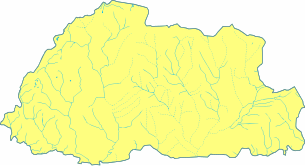Provinces of Bhutan
The Provinces of Bhutan were historical regions of
Dzongkhag). Provincial titles such as Penlop of Trongsa and Penlop of Paro carry on, however, wholly subordinate to the Royal House.[citation needed
]
Traditionally, Bhutan comprised nine provinces: Trongsa, Paro, Punakha, Wangdue Phodrang, Daga (also Taka, Tarka, or Taga), Bumthang, Thimphu, Kurtoed (also Kurtoi, Kuru-tod), and Kurmaed (or Kurme, Kuru-mad). The Provinces of Kurtoed and Kurmaed were combined into one local administration, leaving the traditional number of governors at eight. While some lords were Penlops, others held the title Dzongpen (Dzongkha: རྗོང་དཔོན་; Wylie: rjong-dpon; also "Jongpen," "Dzongpön"); both titles may be translated as "governor."[1]
History
Paro Dzong, administrative headquarters of historical Paro Province
Trongsa Penlop
, Zung Donyer [dronyer], Deb Zimpon, and elder son of Thimphu Jongpen.Under Bhutan's early theocratic
dual system of government, decreasingly effective central government control resulted in the de facto disintegration of the office of Shabdrung after the death of Shabdrung Ngawang Namgyal in 1651. Under this system, the Shabdrung reigned over the temporal Druk Desi and religious Je Khenpo. Two successor Shabdrungs – the son (1651) and stepbrother (1680) of Ngawang Namgyal – were effectively controlled by the Druk Desi and Je Khenpo until power was further splintered through the innovation of multiple Shabdrung incarnations, reflecting speech, mind, and body. Increasingly secular regional lords (penlops and dzongpons) competed for power amid a backdrop of civil war over the Shabdrung and invasions from Tibet, and the Mongol Empire.[2] The penlops of Trongsa and Paro, and the dzongpons of Punakha, Thimphu, and Wangdue Phodrang were particularly notable figures in the competition for regional dominance.[2][3] During this period, there were a total of nine provinces and eight penlops vying for power.[4]
The
dzongs. The Penlop of Paro, unlike Trongsa, was an office appointed by the Druk Desi's central government. Because western regions controlled by the Penlop of Paro contained lucrative trade routes and the most fertile agricultural lands, it became the object of competition among aristocratic families.[5]
The 10th
See also
- Penlop
- Dzongpen
- House of Wangchuck
- Districts of Bhutan
- History of Bhutan
- Dual system of government
References
- ISBN 81-7304-567-4. Retrieved 2011-08-14.
- ^ a b
 This article incorporates text from this source, which is in the public domain. Worden, Robert L. (September 1991). Savada, Andrea Matles (ed.). Bhutan: A Country Study. Federal Research Division. Administrative Integration and Conflict with Tibet, 1651–1728.
This article incorporates text from this source, which is in the public domain. Worden, Robert L. (September 1991). Savada, Andrea Matles (ed.). Bhutan: A Country Study. Federal Research Division. Administrative Integration and Conflict with Tibet, 1651–1728.
- ^
 This article incorporates text from this source, which is in the public domain. Worden, Robert L. (September 1991). Savada, Andrea Matles (ed.). Bhutan: A Country Study. Federal Research Division. Civil Conflict, 1728–72.
This article incorporates text from this source, which is in the public domain. Worden, Robert L. (September 1991). Savada, Andrea Matles (ed.). Bhutan: A Country Study. Federal Research Division. Civil Conflict, 1728–72.
- ISBN 81-206-1504-2. Retrieved 2011-08-10.
- ^ ISBN 1-55939-194-4. Retrieved 2011-08-10.
- ISBN 1-74059-529-7. Retrieved 2011-08-09.

